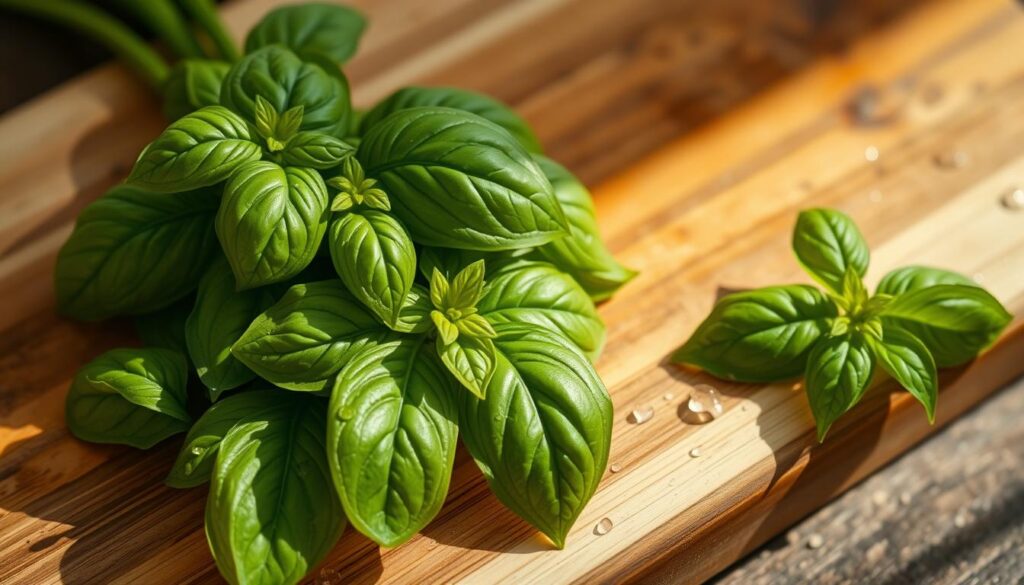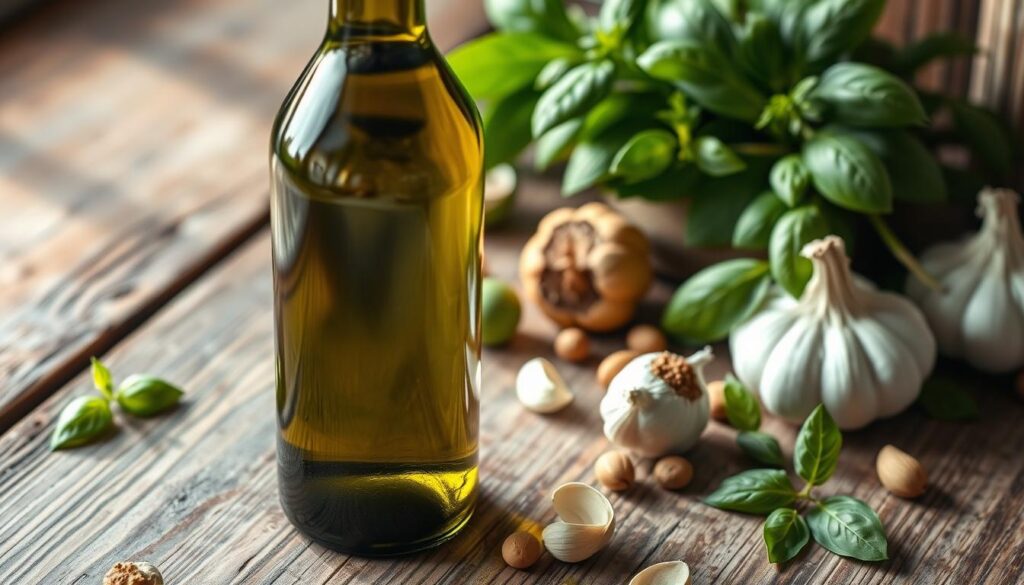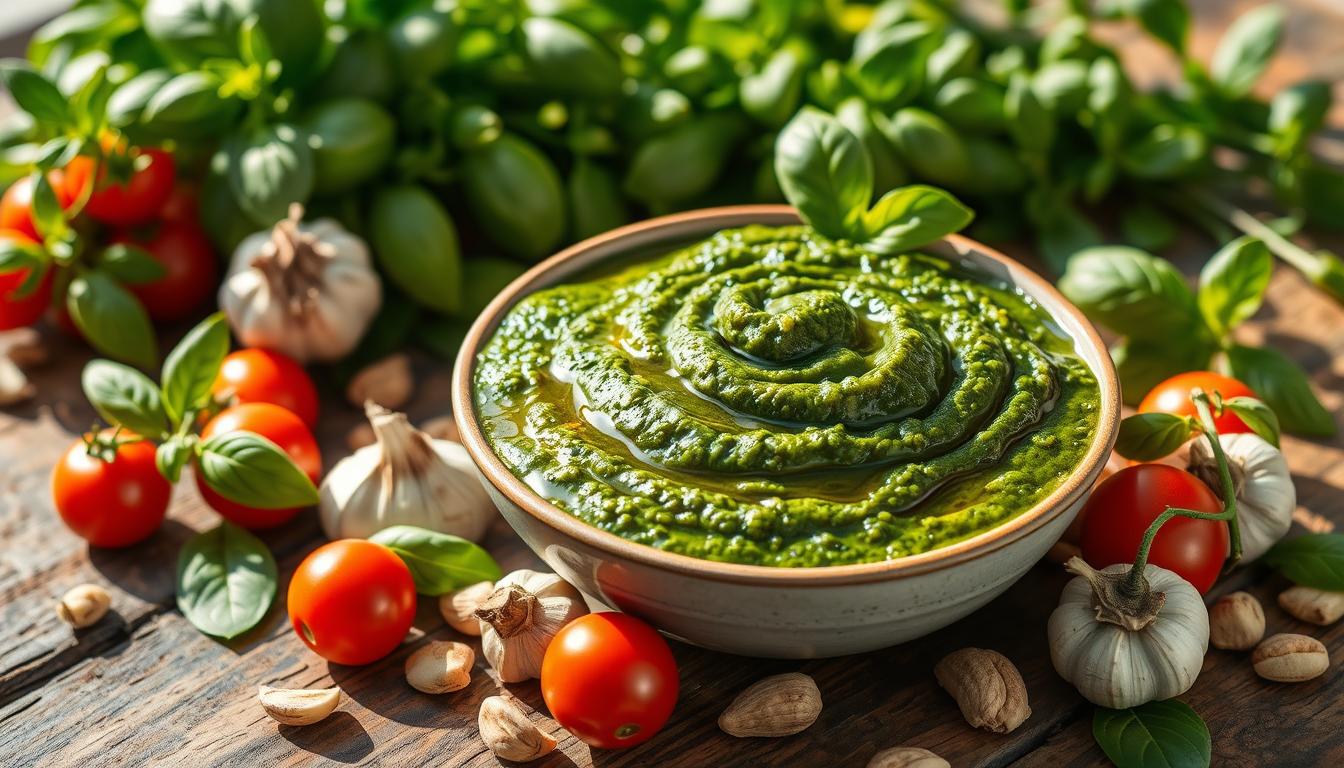This post contains affiliate links.
Ready to tantalize your taste buds with a burst of Italian flavor? Look no further than basil pesto! This herb sauce is a true gem of Italian cuisine. It’s packed with freshness and versatility that’ll make your taste buds dance. Whether you’re dolloping it on pasta or spreading it on a sandwich, basil pesto is the secret weapon your kitchen’s been missing.
Originating from the sun-soaked streets of Genoa, this no-cook sauce has been jazzing up dishes since the 16th century. The magic lies in its simplicity: tender Genovese basil leaves, garlic, pine nuts, olive oil, and hard cheese come together in a symphony of flavors. But don’t let its age-old roots fool you – this basil pesto pasta topping is as hip and happening as ever in modern kitchens.
Crafting the perfect pesto is an art form. Picture yourself wielding a marble mortar and wooden pestle, channeling your inner Italian nonna as you crush and blend. Or, if you’re short on time (and arm strength), a food processor works wonders too. The key is to keep things cool – literally! Chilling your olive oil and working in batches helps maintain that Instagram-worthy green hue.
Key Takeaways
- Basil pesto originates from Genoa, Italy, dating back to the 16th century
- Traditional ingredients include basil, garlic, pine nuts, olive oil, and hard cheese
- Pesto can be made by hand or with a food processor for convenience
- Chilling ingredients and proper blending techniques help prevent oxidation
- This versatile sauce pairs well with pasta, sandwiches, and even as a dip
- Homemade pesto can be stored in the fridge for up to 5 days or frozen for longer shelf life
The Origins of Basil Pesto
Pesto alla Genovese is a key part of Italian food. It comes from Genoa and has won hearts for many years. It’s loved by people all over the world.
A Brief History of Pesto alla Genovese
The tale of pesto starts in the 1850s with basil as the main player. An early American recipe from 1928 had butter and cream, unlike today’s version. It became popular in North America in the 1980s and 1990s, spreading its flavors far and wide.
Traditional Ingredients and Preparation
Real pesto alla Genovese uses top-notch ingredients. It mixes fresh basil, pine nuts, garlic, Parmesan cheese, and olive oil. These are ground together with a mortar and pestle, enhancing each flavor.
Cultural Significance in Italian Cuisine
In Italy, pesto is more than a sauce; it’s a symbol of culture. It’s often paired with pasta like mandilli de sæa, trofie, or trenette. It also adds richness to Genovese minestrone soup. The biennial Genovese Pesto al Mortaio competition celebrates it, where chefs compete to make the best pesto.
| Pesto Fact | Detail |
|---|---|
| Origin | Genoa, Italy |
| Traditional Method | Mortar and Pestle |
| Key Ingredients | Basil, Pine Nuts, Garlic, Parmesan, Olive Oil |
| Shelf Life (Refrigerated) | Up to 1 week |
| Popular Pasta Pairings | Trofie, Trenette, Mandilli de sæa |
Essential Ingredients for Authentic Basil Pesto

Ready to make a delicious basil pesto? You’re in for a treat! This Italian classic is loved by many, with a rating of 4.97 out of 5. In just 5 minutes, you’ll have a cup of green gold ready to make any dish better.
Let’s explore the key ingredients that make pesto special:
- Fresh basil: 2 cups of tender leaves, bursting with flavor
- Pine nuts: ½ cup, toasted to perfection
- Extra-virgin olive oil: ¼ cup of liquid gold
- Parmesan cheese: ¼ cup, freshly grated (optional, but oh-so-good)
- Garlic: 1 small clove, for that signature kick
- Lemon juice: 2 tablespoons to brighten things up
- Sea salt: ¼ teaspoon to enhance all flavors
- Black pepper: A few grinds to taste
The secret to great pesto is using fresh, high-quality ingredients. Look for young, vibrant basil leaves for the best taste and color. Choose light and delicate olive oil to let the basil shine. For the cheese, authentic Parmigiano-Reggiano from Italy will elevate your pesto.
Want to try something new? Swap pine nuts for walnuts or almonds. Or, if you’re vegan, skip the cheese or add nutritional yeast for a cheesy taste. The most important thing is to use the freshest ingredients you can find. Now, grab your food processor and let’s make some pesto!
The Art of Selecting Fresh Basil
Choosing the right fresh basil is key to making great pesto. The basil you pick can greatly affect your dish’s taste. So, it’s important to know how to pick the best herbs.
Identifying the Best Basil Varieties
For pesto, Genovese basil is the top choice. It comes from Italy’s Liguria region and has a strong, sweet flavor. Look for leaves that are small and round, curling under like spoons. These leaves give the best taste and color to your pesto.
Tips for Storing and Preserving Basil
After picking your basil, it’s important to store it right to keep it fresh. For short-term use, put the stems in a jar of water on your counter. For longer storage, wrap the leaves in a clean towel and refrigerate. Basil is delicate, so be gentle when handling it.
The Importance of Small, Tender Leaves
Small, tender leaves are crucial for a vibrant green color and true flavor in pesto. These young leaves have more flavor and blend better than bigger ones. When washing, use cold water quickly to keep the essential oils in. Dry them well before using.
| Basil Selection Tips | Why It Matters |
|---|---|
| Choose Genovese basil | Best flavor for traditional pesto |
| Select small, tender leaves | Brighter color and smoother texture |
| Avoid wilted or spotted leaves | Ensures freshness and quality |
| Proper storage techniques | Maintains flavor and extends shelf life |
By following these tips, you’ll make pesto as good as Chef Paolo Laboa’s gold medal-winning dish!
Choosing the Right Olive Oil for Your Pesto

Choosing the right olive oil is key to making great pesto. Extra virgin olive oil is the top choice. It adds a light flavor that lets the basil shine.
Ligurian olive oil is the best, but it’s hard to find. But don’t worry, there are other great oils to use. Look for ones that are light and mild. This way, your pesto won’t taste bitter.
Remember, you’re making pesto, not garlicky roasted broccoli! The right olive oil is like a supporting actor. It makes the star shine without taking over.
Here are some top olive oils to try:
| Olive Oil Brand | Flavor Profile | Best For |
|---|---|---|
| Graza Sizzle | Balanced, versatile | All-around usage |
| Cobram Estate California Select | Herbaceous, peppery | Bold pesto lovers |
| Bertolli Extra Virgin Rich Taste | Robust, inexpensive | Budget-friendly option |
| Bono Sicilia PGI Organic | Fruity, buttery | Smooth, mellow pesto |
Steer clear of strong, peppery olive oils. They can overpower your pesto’s flavors. It’s like having a friend who always tries to outdo you.
The Role of Pine Nuts in Basil Pesto
Pine nuts are key to basil pesto’s creamy texture and nutty flavor. These small, buttery seeds add depth and richness. They perfectly complement the fresh basil.
Toasting Pine Nuts for Enhanced Flavor
Toasting pine nuts before adding them to pesto can elevate its taste. This simple step brings out their natural oils and intensifies their nutty taste. To toast, spread the pine nuts in a single layer on a baking sheet and roast at 350°F for 5-7 minutes, stirring occasionally until golden brown.
Suitable Substitutes for Pine Nuts
If pine nuts are unavailable or you’re looking for a cost-effective alternative, consider these nut substitutes:
- Walnuts: Offer a similar buttery texture
- Pecans: Provide a sweet, nutty flavor
- Almonds: Add a subtle crunch and mild taste
While these alternatives will change the traditional flavor profile, they can still create a delicious pesto. You might even discover a new favorite combination! Speaking of new flavors, why not try incorporating radishes into your next meal? Explore some delightful radish recipes for a fresh twist on your culinary adventures.
Proper Storage of Pine Nuts
To keep your pine nuts fresh and prevent spoilage, store them in an airtight container in the freezer. Their high fat content makes them prone to rancidity, but proper storage can extend their shelf life up to 6 months. Always give them a quick sniff test before use to ensure they haven’t gone bad.
| Nut Type | Flavor Profile | Best Storage Method | Shelf Life |
|---|---|---|---|
| Pine Nuts | Buttery, Mild | Freezer | Up to 6 months |
| Walnuts | Bold, Earthy | Refrigerator | Up to 1 year |
| Pecans | Sweet, Rich | Refrigerator | Up to 9 months |
| Almonds | Mild, Crunchy | Pantry | Up to 2 years |
Cheese Selection: Parmesan and Pecorino Romano
Ready to take your pesto to the next level? Let’s dive into cheese! The key to authentic Italian taste is in choosing Parmigiano-Reggiano and Pecorino Romano. These cheeses add unique flavors to your pesto.
Parmigiano-Reggiano is the top Italian cheese, known for its sweet, nutty taste. It’s aged for at least a year. On the other hand, Pecorino Romano is a sharp, salty cheese made from sheep’s milk. It’s aged for 8-12 months.
For the best pesto, mix Parmigiano-Reggiano and Pecorino Romano in a 3:1 ratio. This mix creates a perfect balance of flavors without overpowering the basil.
“The cheese is the soul of the pesto. Choose wisely, and your taste buds will thank you!”
Authenticity is key! Look for the special seal on genuine Parmigiano-Reggiano rinds. Pecorino Romano’s PDO status means it’s from Sardinia, Italy. Your pesto needs these top-notch Italian cheeses!
| Cheese | Flavor Profile | Aging Time | Best Used For |
|---|---|---|---|
| Parmigiano-Reggiano | Sweet, nutty | 1+ years | Subtle, complex dishes |
| Pecorino Romano | Salty, tangy, grassy | 8-12 months | Strong-flavored dishes |
Now you know all about cheese for pesto. Make pesto perfection and change your pasta game forever.
Basil Pesto: Traditional Preparation Methods
Making the perfect basil pesto is an art that can boost your cooking skills. Whether you’re a pro or just starting, learning these traditional ways will help you make a delicious and authentic pesto. Your taste buds will thank you.
Mortar and Pestle Technique
Get into the Italian spirit with a mortar and pestle! This method slowly crushes ingredients, releasing oils and flavors. Start with garlic and pine nuts, then add basil leaves bit by bit. You’ll get a pesto that’s rich and textured.
Food Processor Method
When you’re short on time, your food processor is your best friend. It makes pesto fast and evenly. Chill the blade and bowl to keep your basil bright green. Pulse ingredients in short bursts for the perfect texture.
Hand-Chopping for Authentic Texture
For a rustic, hand-chopped pesto, use a sharp knife or mezzaluna. This method keeps basil flecks and avoids a uniform paste. It’s more work, but the taste and authenticity are worth it!
| Method | Texture | Time | Flavor Intensity |
|---|---|---|---|
| Mortar and Pestle | Smooth, Creamy | 15-20 minutes | Very High |
| Food Processor | Uniform, Slightly Grainy | 5-10 minutes | High |
| Hand-Chopped | Chunky, Rustic | 20-30 minutes | High |
Choose your method, but remember, fresh ingredients and love are key to great pesto. Now, let’s get pesto-making!
Tips for Preventing Oxidation in Your Pesto
Want to keep your green pesto looking fresh? Let’s fight pesto oxidation! You’ve made a tasty basil dish, and now it’s time to keep it green. Basil browning is a pesto enemy, but we have some clever tips.
Start with citrus! A bit of lemon juice (about 2 tablespoons per batch) is great. It has a pH of 2.0-2.5, fighting off brown spots. This zesty touch keeps your pesto fresh for up to 5 days and adds flavor.
For a fancy touch, blanch your basil leaves for 15 seconds before blending. This stops browning enzymes. It’s like a spa for your basil. Or, just chill everything before making your pesto to avoid heat damage.
Finally, cover your pesto with olive oil. This keeps oxygen out and greenness in. Your pesto will stay vibrant, whether on sandwiches or pasta. Now, go make your pesto shine!
FAQ
What is basil pesto?
What are the traditional ingredients in authentic pesto alla Genovese?
What type of basil is best for making pesto?
What kind of olive oil should I use for pesto?
Can I substitute pine nuts in basil pesto?
What cheese is used in traditional pesto?
What is the traditional method for making pesto?
How can I prevent my pesto from oxidizing and turning brown?
This post contains affiliate links.

